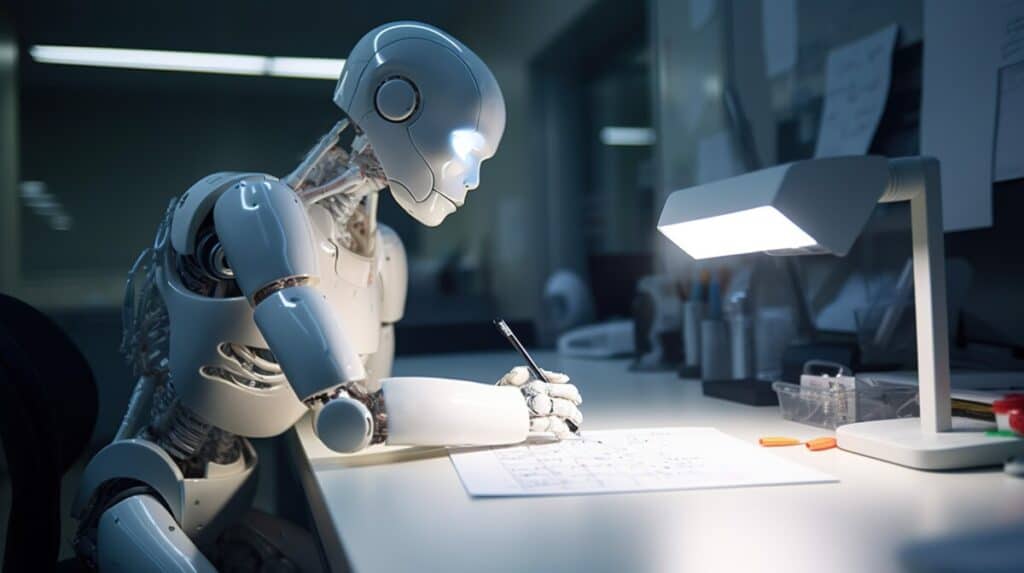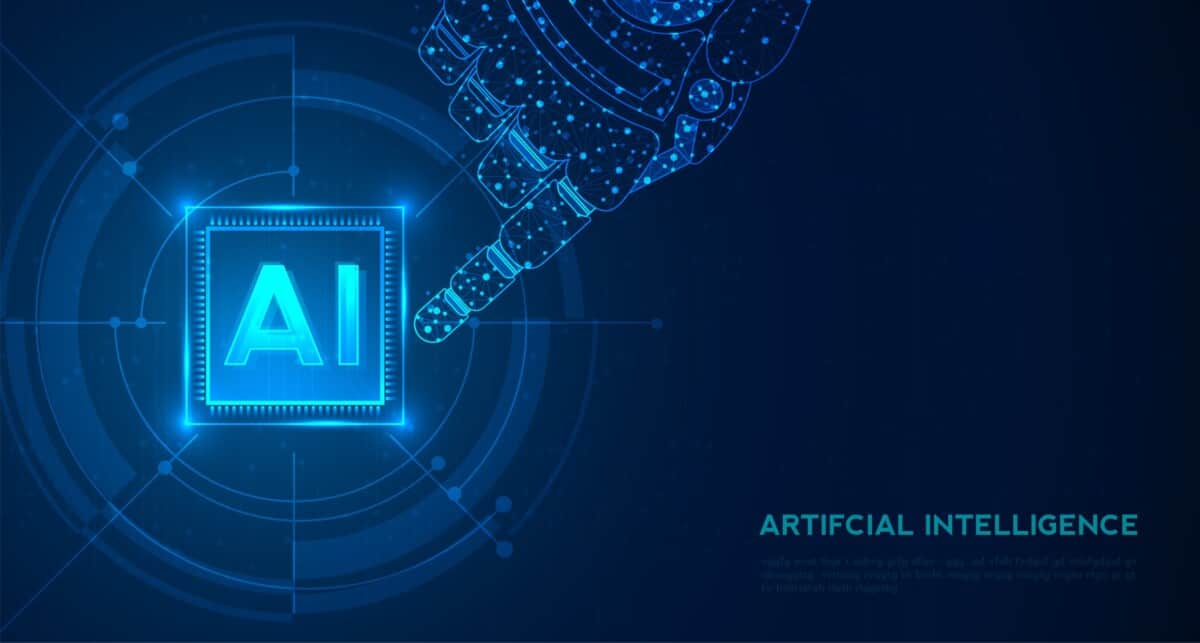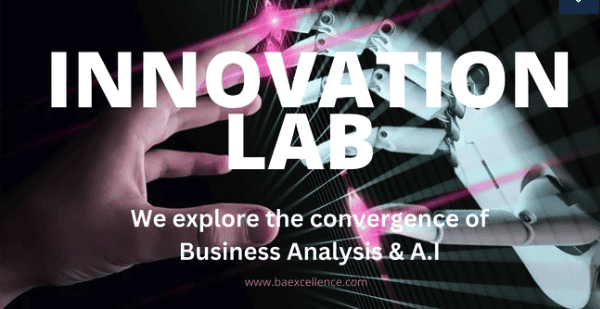Artificial Intelligence (AI) is now something that even non-technical person use on a daily basis and, at the same time, a tool that has the potential to disrupt and transform entire industries.
One of the fields that is certain to feel the impact of this new technology is, without a doubt, business analysis. A part of a business analyst’s job is analysing and organising data to gain better insights, identify new opportunities for the organisation, and, ultimately, improve decision-making.
Modern AI tools can be of great help in expanding the boundaries of traditional analysis and unlocking deeper layers of understanding the available information, as well as streamlining the whole process and making the business analysts job somewhat easier, especially when it comes to more mundane and repetitive tasks.
Artificial intelligence could easily become a game changer in the field, helping companies develop more efficient strategies and gain a competitive edge on the market.
However, like all new technologies, AI also comes with certain risks and limitations. Therefore, one of the main skills of business analysts in the future will be the ability to properly understand the way AI works and learn how to leverage it to properly harness, interpret, and leverage data.
But, before we move on to exploring the symbiotic relationship between business analysis and artificial intelligence, let’s first explain the basics of AI technology.
Table of Contents
What is Artificial Intelligence (AI)?
Artificial intelligence refers to computer systems that are capable of performing tasks that are commonly considered to require human intelligence. AI, essentially made of a bunch of algorithms, encompasses a wide range of different technologies that allow computers to perceive, synthesise, and infer data, as well as mimic human cognition or replicate processes such as reasoning, learning, and problem-solving. This way, machines are able to gather and interpret large and complex sets of information, recognise and predict patterns, and adapt to new situations. All of this is, obviously, very useful when it comes to business analysis.
Although artificial intelligence has only recently gained mainstream attention and become more widely used, it has been around for a while, in one form or another. The technology and the term itself can be traced to the mid-20th century when scientists and researchers first began to entertain the idea of intelligent machines. They started to create algorithms and software that were capable of performing rudimentary tasks that would typically need human intelligence.
Later, in the 60s and 70s, the focus shifted to designing systems that could replicate the decision of human experts in certain fields and the technology has become frequently utilised in industries such as finance, medicine, and engineering. As time went on, researchers kept working on new ideas, including machine learning, natural language processing, or image recognition, all the way to the latest developments, including quantum computing and neuromorphic computing
- Computer vision is the ability of computers to recognise, interpret and analyse visual information, such as images or videos, and react to what they “see.”
- Fuzzy logic is supposed to mimic human recognition and reasoning, particularly in cases when the information is uncertain. This allows AI to deal with ambiguity and involve various degrees of truth in decision-making.
- Expert systems replicate the decision-making process of human specialists in specific fields. These systems rely on expert knowledge to appropriate and well-informed solutions to complex problems.
- Robotics features a combination of mechanical engineering and artificial technology, with the goal of designing machines that can work autonomously and physically interact. Robots, made this way, are capable of performing precise movements and dangerous tasks, as well as gathering data from the environment.
- Machine Learning is a field of artificial intelligence dealing with the ability of systems to learn from the available data and improve their performance on their own, without human input.
- Neural Networks / Deep Learning tries to mimic the structure and functions of the human brain and involves complicated training models that help AI process complex hierarchies and patterns.
- Natural Language Processing or NLP is supposed to help machines understand and interact with human language. The most common tasks and areas of use include speech recognition, text summarisation, and sentiment extraction.
Business Analysis and Artificial Intelligence
One of the main goals of business analysis
However, with the modern world moving at a frantic pace, the amount of data gathered from consumers, the market, and the general environment in which the company operates, makes processing and even gathering all the information often impossible to be done by humans.
And, this is where AI for business analysis steps in, as one of the biggest strengths of artificial intelligence is the ability to quickly perform tasks such as organising analysing data, and making predictions based on that data.
Modern machine-learning algorithms are capable of extracting insights from multiple sources and identifying trends from gathered data which can be of great help in BA’s day-to-day job. If nothing else, automatically collecting and processing much more information than any human is capable of, saves plenty of time and allows business analysts to focus on strategic considerations and higher-level analysis.
Of course, when it comes to strategic decisions, creative thinking, and communication skills humans are still irreplaceable, so the role of business analysts is still vital in helping the company achieve its goals.
AI tools such as ChatGPT can be used to provide efficiencies to the business analysis to remove burdens and repetitive tasks and help enable the business analyst to explore the problem domain by asking the right probing questions and essentially bring together b
How Can Business Analysts Use AI?
Artificial intelligence offers business analysts almost endless possibilities when it comes to using it within their scope of work. While most BAs already use AI in one way or the other, mastering the technology and getting to know what AI can do can add to their existing set of skills and make them even more valuable to the organisation.
Below are some of the main ways AI can be leveraged as a powerful AI tools (such as ChatGPT
Low-Level Tasks
Most people, and business analysts as well, use AI as a tool to automate and perform mundane and repetitive tasks that otherwise can take a huge chunk of valuable time. Assigning AI to these low-level tasks frees up business analysts and allows them to focus on more complex and challenging work instead of getting bogged down on the details.
This mainly means that you can put AI in charge of jobs such as data entry, collection, and cleansing. Artificial intelligence can not only successfully perform these tasks, but do it much faster and in greater scope than any human could.
Enhanced Data Analysis
However, artificial intelligence, especially with breakthroughs made in recent years, is also capable of more complicated and higher-level tasks. It can provide business analysts with valuable insights it extracts from large and complex data sets. Furthermore, AI is able to process and analyse enormous amounts of data which it can use to identify certain patterns and find correlations that a human may otherwise miss.
This way, by leveraging AI for business analysis, a company can gain a better understanding of its customers, their needs, current trends in the market, and its own operational inefficiencies. Plus, AI can prepare data and make it easier for human analysis by organising and visualising it through various tables, charts, or presentations.
Forecasting
Predictive analysis is another area where AI can be of great help to business analysts. So, artificial intelligence is not only capable of performing descriptive analysis but also forecasting future outcomes, identifying potential risks, and identifying upcoming trends.
It does so by using machine learning and data mining to analyse the existing historical data and make predictions based on the analysis of that information. Needless to say, this is of great use for any company, as it can allow for better allocation of resources, strategic modifications, and proactive decision-making.
Helping with Requirements Elicitation
Among other things, AI can be used to automatically create various documents, which can be a true time-saver for business analysts. This includes documentation such as use cases or functional specifications. AI can do this by analysing the available data, such as stakeholder interviews or similar sources of information.
Once the AI understands the context and domain of a certain project it can suggest possible requirements, based on requirements already available in the organisation and their constructs, design specifications, and test cases. This makes it much easier for BAs to elicit requirements for a certain project. This type of task is mainly done by intelligent chatbots, trained by using LLMs (Large Language Models)
Requirement Analysis
AI tools can be trained to analyse given requirements and detect and identify various trends, conflicts, or contradictions. This way, a business analyst can make sure that the requirements are unambiguous, consistent, understandable, and complete.
Of course, you can’t simply rely on AI to do all the work, but it comes more than handy as a sort of quality control and as a tool for expanding your BA capabilities.
Communication and Documentation Management
Modern and advanced chatbots, such as ChatGPT can also be sued to automatically generate various presentations, reports, and other communication tools. They do this based on the information and information gathered from the stakeholders.
As a big part of a business analyst’s job is communicating and managing stakeholders, this can significantly speed up and streamline that process.
Monitoring in Real Time
Needless to say, modern companies operate in an extremely fast-paced and hectic environment, so timely information and reaction are often the key to gaining a competitive edge on the market.
Monitoring systems based on artificial intelligence have proven to be very helpful here, as they can track all the KPIs (Key Performance Indicators) continuously and in real time, alerting business analysts whenever there’s an issue or when an anomaly occurs.
By identifying the issues on time, organisations can promptly react and decrease potential risks, thus increasing their efficiency and, ultimately, better serving customer needs.
Improving Customer Experience
Most companies, especially large ones, have massive amounts of data related to their customers. This includes information on customer behaviour, preferences, purchasing history, and many more.
AI systems can help business analysts leverage all this information and more easily pinpoint customer needs, create marketing campaigns, modify the product if needed, and improve customer engagement. By doing so, the company is likely to increase customer loyalty and perform better in the market.
Will AI Replace Business Analysts?
One of the main concerns in the BA community regarding artificial intelligence is that it may eventually take their jobs. However, despite all the technological developments and breakthroughs, AI still can’t replace humans in the business analysis process. There are still plenty of aspects of a business analyst’s job the AI is simply not capable of performing due to the lack of emotional intelligence, creative thinking, and communication skills.
While AI can be very useful as a tool in problem-solving, it’s still no match for creativity and innovative solutions humans can come up with. As they think creatively and critically, business analysts, while leaning on their experience, are capable of coming up with out-of-the-box solutions that can help a company overcome an issue that has never occurred before.
The ability to view the problem from different perspectives and cooperate with other stakeholders still makes human problem-solving ability unique. Plus, a good business analyst is able to motivate their team members and all the stakeholders working on a project so they all work towards the common goal.
BAs, unlike AI, are able to understand human elements that go into the operation of the company and are able to prioritise the needs and capabilities of the actual people involved in a process. This involves considering the impact every decision may have on employees, customers, and every other stakeholder.
So, while every business analyst should learn how to use AI and leverage it to improve the analysis and efficacy of their solutions, crucial decisions about the future of the company can still only be made by experienced analysts.

Reasons why it is Unlikely that AI will Replace Business Analysts
While artificial intelligence (AI) is capable of automating certain tasks and providing insights, it is unlikely to replace business analysts entirely.
Here’s why:
Complex decision-making – business analysts possess domain knowledge, critical thinking skills, and an understanding of business context that allows them to make complex decisions. AI, on the other hand, relies on data and algorithms to make decisions and lacks the contextual understanding that human analysts bring to the table. Business analysts excel at analysing multiple factors, weighing different options, and considering the broader implications of decisions.
Stakeholder Interaction – business analysts frequently interact with stakeholders, such as business managers, clients, and technical teams. They elicit requirements, facilitate communication, and manage expectations. These interpersonal skills and relationship-building capabilities are crucial for successful collaboration and understanding stakeholder needs, which AI systems currently cannot replicate.
Adaptability and Creativity – business analysts often encounter new and unique challenges that require creative problem-solving. They adapt their approaches, think critically, and apply their expertise to find innovative solutions. AI, while powerful in processing large amounts of data, lacks the adaptability and creative thinking abilities of human analysts.
Interpretation and Judgment – AI systems operate based on patterns and data correlations, but they may not always interpret context or nuances accurately. Business analysts, on the other hand, can understand complex business scenarios, interpret qualitative information, and exercise judgment in decision-making. They can weigh different perspectives, consider ethical implications, and handle ambiguous situations, which are essential skills for effective analysis and decision support.
Human Element – business analysts often act as facilitators, working with cross-functional teams, gathering diverse viewpoints, and guiding discussions. They provide a human touch to the analysis process, fostering collaboration, and ensuring that different perspectives are considered. This interpersonal aspect of their role cannot be fully replaced by AI.
While AI can augment the work of business analysts by automating repetitive tasks, performing data analysis, and providing insights, the role of business analysts is likely to evolve rather than be replaced. Business analysts will continue to be valuable in areas such as strategic thinking, stakeholder management, problem-solving, and contextual understanding, where human expertise and judgment are essential.
Innovation Lab – AI Tools For Empowered Business Analysts
You can join a community of business analysis discussing things all AI and gain access to 6 live virtual workshops, expert guidance, valuable resources, and leading insights.
Don’t miss an opportunity to shape your future in business analysis and AI. Subscribe and gain an transformative learning experience 


